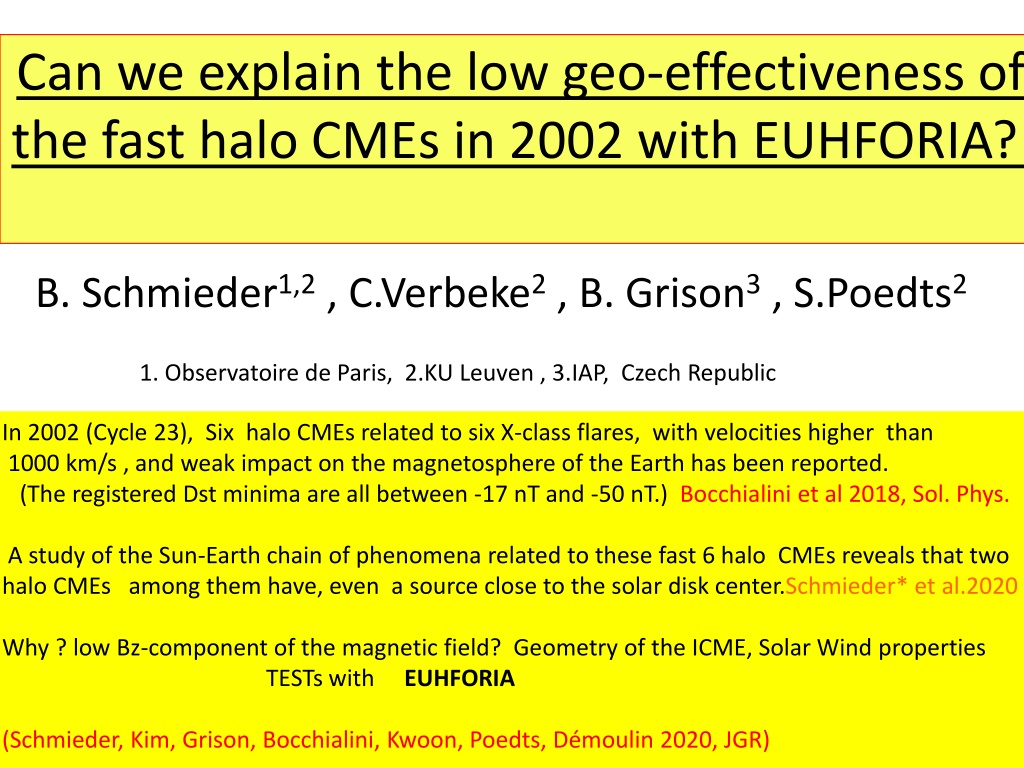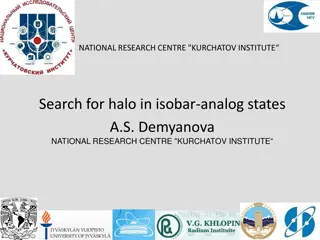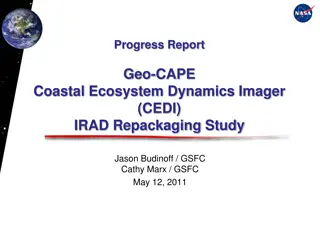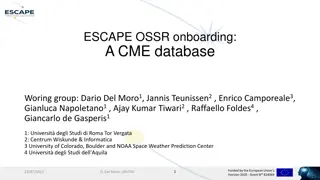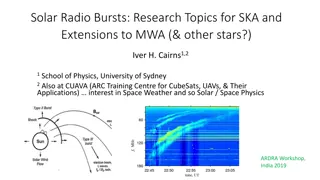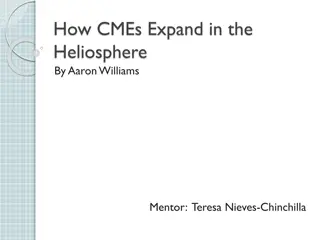Understanding Low Geo-Effectiveness of Fast Halo CMEs in 2002 with EUHFORIA
Study investigates the puzzling low impact of fast halo CMEs associated with X-class flares in 2002 on Earth's magnetosphere. Despite high velocities, the weak geomagnetic effects were linked to a low Bz-component of the magnetic field, lack of relationship with longitude, and other factors. Utilizing EUHFORIA and considering solar wind properties, the analysis aims to explain this anomaly.
Download Presentation

Please find below an Image/Link to download the presentation.
The content on the website is provided AS IS for your information and personal use only. It may not be sold, licensed, or shared on other websites without obtaining consent from the author. Download presentation by click this link. If you encounter any issues during the download, it is possible that the publisher has removed the file from their server.
E N D
Presentation Transcript
Can we explain the low geo-effectiveness of the fast halo CMEs in 2002 with EUHFORIA? B. Schmieder1,2, C.Verbeke2, B. Grison3, S.Poedts2 1. Observatoire de Paris, 2.KU Leuven , 3.IAP, Czech Republic In 2002 (Cycle 23), Six halo CMEs related to six X-class flares, with velocities higher than 1000 km/s , and weak impact on the magnetosphere of the Earth has been reported. (The registered Dst minima are all between -17 nT and -50 nT.) Bocchialini et al 2018, Sol. Phys. A study of the Sun-Earth chain of phenomena related to these fast 6 halo CMEs reveals that two halo CMEs among them have, even a source close to the solar disk center.Schmieder* et al.2020 Why ? low Bz-component of the magnetic field? Geometry of the ICME, Solar Wind properties TESTs with EUHFORIA (Schmieder, Kim, Grison, Bocchialini, Kwoon, Poedts, D moulin 2020, JGR)
The 12 X-class flares and Halo CME Here we work on two CMEs 2 CMEs with source at the disk center The 2 X flares with halo CME are related a weak Dst minimum : Why?
Relationship with the longitude Preferential longitudes (Webb 2002, Lee etal 2014, Vasanth 2015) due the Parker spiral on the West. But SEP can go through the magnetic field lines (Podgorny 2018). These 2 CMEs Ip < 104 Dst moderate and weak There is NO relationship with the longitude, X class flares come from the limb in 2002 !
AR 10030 source of CMEs Energy of the flare Meudon Ca K Star spots Aulanier, Janvier, Schmieder 2003 Syndrom of the big flare big CMEs but you need big stress
AR 10030 source of CMEs Complex active region .. Big Stress
AR 10030 Source of the halo CME -15 July
The geoeffectivity related to the12 X- Class flares - ICME at L1
NO Relationship between flare CME and Dst and IP Too low number ?
Solar Wind and ICME of 17 july ( CME 1: 15 July) Black curve: Bz North Bz very noisy First reason of Weak geoeffectiveness Richardson and Cane 2010
Solar Wind and ICME of 17 july ( CME 15 July) Why a so low Solar Wind? The temperature Is increasing why? May be the flux rope is hot? DST = -13 nT
sheath Second CME CME 18 July ICME 20 July Dst = -28 nT Low density ?
sheath CME 18 July ICME 20 July Dst = -28 nT Temperature High because Hot flux rope? Like in Dasso et al. JGR, 108, NO. A10, 1362
EUHFORIA European heliospheric forecasting information asset Solar wind at @ 0.1 AU Semi-empirical: Gong/ADAPT magnetogram PFSS WSA/DCHB+CSC CMEs at @ 0.1 AU Cone model Spheromak Inner Heliosphere 0.1 AU 2.1 AU Time-dependent 3D MHD (FVM + CT approach for advancing B div-free) Credit: Jens Pomoell
EUHFORIA modeling Background solar wind: MWO CR1991 synopic map CMEs launched on 15thand 18thof July ICMEs at 17thand 20thof July Results for the solar wind
Project with EUHFORIA We performed a set of EUHFORIA simulations in an attempt to explain the low observed Dst and the observed magnetic fields. We study the degree of deviation of these halo CMEs from the Sun-Earth axis and as well as their deformation and erosion due to their interaction with the ambient solar wind (resulting in magnetic reconnections) according to the input of parameters and their chance to hit other planets. The inhomogeneous nature of the solar wind and encounters are also important parameters influencing the impact of CMEs on planetary magnetospheres.
Conclusion 1 by analysis of the chain of events: (flare, CME, L1, SEP, and ground-based indices in a previous paper (Schmieder et al 2020*) We analysed the causes of weak geo-effectiveness (Dst, SEP) of the 12 X-class flares. 2 All the good proxies to forecast an intense geo-effective storm do not work in 2002. The X-class flares with fast halo CMEs are related only to weak geomagnetic disturbances 3 We need to understand why halo CMEs with high velocities > 1000 km/s are related to only weak geo-effectiveness. 4 Tests with EUHFORIA - --Role of interaction with other ICMEs --- Deflection of the ICME ---Asymmetry N/S ---B*z <0 during a too short time Schmieder, Kim, Grison, Bocchialini, Kwoon Poedts, D moulin 2020, JGR
